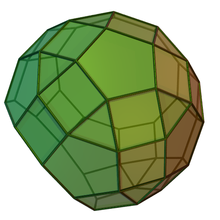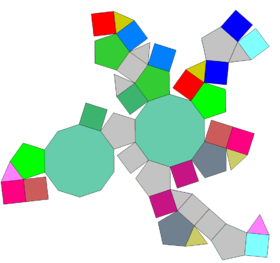Gyrate bidiminished rhombicosidodecahedron
| Gyrate bidiminished rhombicosidodecahedron | |
|---|---|
 | |
| Type | Johnson J81 - J82 - J83 |
| Faces | 10 triangles 20 squares 10 pentagons 2 decagons |
| Edges | 90 |
| Vertices | 50 |
| Vertex configuration | 10.2(4.5.10) 5x2(3.42.5) 4+8.2(3.4.5.4) |
| Symmetry group | Cs |
| Dual polyhedron | - |
| Properties | Convex |
| Net | |
 | |
In geometry, the gyrate bidiminished rhombicosidodecahedron is one of the Johnson solids (J82). It can be produced by removing two pentagonal cupolae and rotating a third pentagonal cupola through 36 degrees.
A Johnson solid is one of 92 strictly convex polyhedra that is composed of regular polygon faces but are not uniform polyhedra (that is, they are not Platonic solids, Archimedean solids, prisms, or antiprisms). They were named by Norman Johnson, who first listed these polyhedra in 1966.[1]
External links
- ^ Johnson, Norman W. (1966), "Convex polyhedra with regular faces", Canadian Journal of Mathematics, 18: 169–200, doi:10.4153/cjm-1966-021-8, MR 0185507, Zbl 0132.14603.
